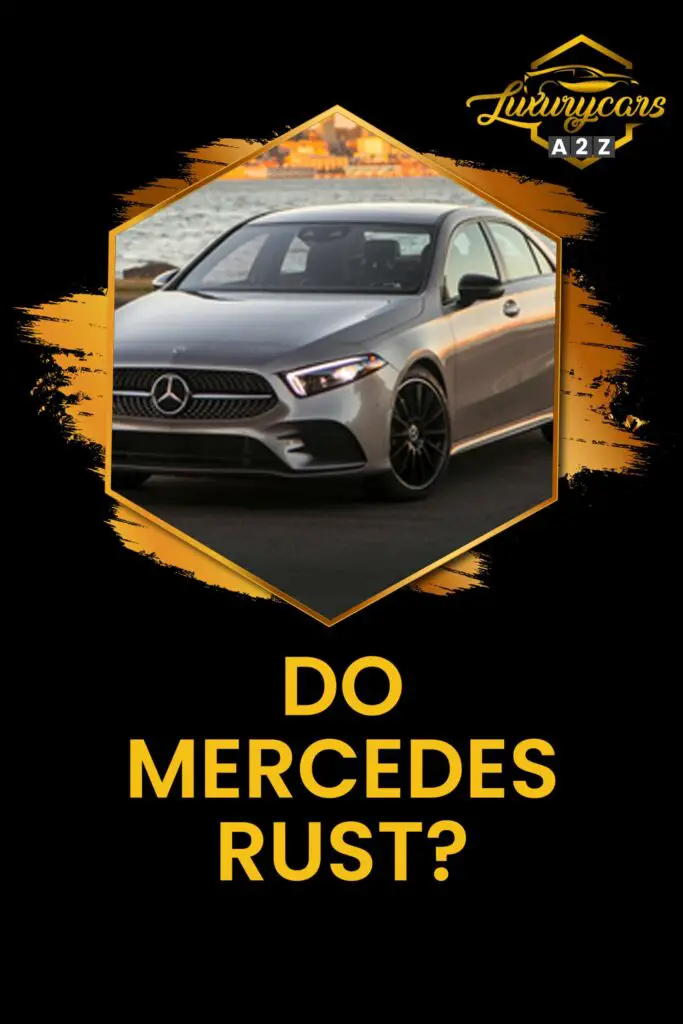One of the reasons Mercedes-Benz is very popular around the world is because of the cars’ luxurious and stunning appearance. However, this luxurious brand also has a share of its problems.
Like other cars, Mercedes do rust. Mercedes may feature some of the most gorgeous, luxurious, and comfortable-looking cars, but rust is one issue that most Mercedes owners face. Note that some Mercedes models have serious rust problems compared to others.
Another read for you: Should you buy a 100k mileage Mercedes?
What Mercedes models have rust issues?
Mercedes models built between 1995 and 2004
Most Mercedes-Benz models built in the late 1990s and early 2000s had rust issues. This was mainly because of the type of paint they were using. The company switched to water-based paint, which was not very durable. It also had thinner layers, meaning it wore out quickly, exposing the cars to the elements.
Some of the Mercedes models that had rust issues between 1995 and 2004 were the Mercedes-Benz W202 C-Class, W210, W208, W220 S-Class, C208 CLK-Class, W210 E-Class, C215 CL-Class, W203 C-Class, and W211 E-Class.
Most Mercedes models from after 2006 haven’t had rust issues.
Models recalled due to rusted bolts
Several Mercedes models built between 2011 and 2016 were recalled because of rust issues. The cars recalled did not fare well in cold areas of Eastern Canada. The reason behind the recall was because of dumping of large deposits of salt on highways during the winter months.
The salt dumped on the highways caused rust to bolts that connected the electric power steering assist motor to the steering housing. With excess corrosion, the unit could dismantle and lead to loss of power steering assist. This proved to be dangerous, and over 21,500 Mercedes cars were recalled.
Most of the models were from the C-Class, E-Class, CLS-Class, S-Class, GLC-Class, GLE-Class, and ML-Class. Regardless, Mercedes advised dealers to replace the mounting bolts and employ a corrosion protection coating to the gear housing and bolts. Another option was to replace the steering gear.
After how many miles do Mercedes start to rust?
Mercedes-Benz is not only expensive to buy, but also to maintain. Even though many luxury cars have rust problems, Mercedes often start to develop these problems quite early. Most models start having rust issues after 120,000 miles or 10 years.
If you own a 10-year-old or older Mercedes car, you should inspect it thoroughly before it gets out of hand. Fixing small rust spots is easier than waiting for them to spread. Rust may also eat into some vital parts, leading to costly repairs.
Which Mercedes parts rust?
Although a Mercedes-Benz is the epitome of a luxury car, after several years of use, the car can develop various problems such as rust. If you have owned your car for more than 10 years, you should start inspecting certain areas before the rust worsens.
With Mercedes-Benz, it is easy to check for rust as it’s more common in certain parts of the car. These include:
- The bottom of the doors
- Behind the license plate
- Below wheel wells
- On bumpers
- Below seats
- Inside the trunk
- Behind the sidewall cover
If you don’t find rust in these areas, then it’s unlikely to be elsewhere. Rust also varies from one car model to another. For example, the S-Class can develop rust on all four doors, which is due to a faulty manufacturing process.
How does Mercedes-Benz protect its cars from rust?
Mercedes has changed a lot of things to make their cars more reliable over the years. Since the complaints about rust between 1995 and 2004 car models, Mercedes cars are now more durable and don’t rust easily. This is thanks to the innovative paint technology used on newer Mercedes.
The innovative paint technology used by Mercedes is known as “Permagard.” This is an aftermarket paint protectant that is created to keep Mercedes in brilliant shape. The innovative paint is used because it helps to form a plastic-like barrier between the real coat and elements, such as sap, acidic rain, bird poop and more.
The Permagard coating also maintains the luxurious look of Mercedes, making it look like new. Unlike protective polishes or waxes, this innovative paint is long-lasting as it adheres to the car’s paint. So, it won’t fade away quickly like polishes or waxes.
Many Mercedes-Benz cars have a long-term rust problem. The ability to ruin the vehicle’s bodywork and, over time, its structural integrity, has made rust a major problem for Mercedes owners.
FAQ about rust and Mercedes-Benz
Which luxury car has more serious rust issues – Audi, BMW, or Mercedes?
Among these three German luxury car brands, Audis are least prone to rust issues, while Mercedes has the most issues with rust. The Audi A3 and A4 rank highly in many comparisons of the cars with the least rust problems. The BMW 3 series follows closely, with the Mercedes-Benz A-Class & GLS-Class coming next.
Do all Mercedes rust?
Although many Mercedes owners have reported rust issues on their cars, not all models rust. So, before you settle for a particular Benz model, make sure that it doesn’t have rust issues. The A-Class and GLS-Class have the fewest rust problems.
Do Mercedes rust in all climates?
Yes, they do. Nevertheless, some climates are harsher on your car than others. For instance, driving a Mercedes in winter exposes it to rust, as there is a lot of salt being thrown around. Additionally, a Mercedes driven in humid climates will rust faster than one driven in a less humid climate.
Can I repair rust on Mercedes?
Of course, you can fix your rust problem! It will be expensive though. Take your car to an authorized Mercedes dealer, or a mechanic that you trust if it’s out of warranty. The mechanic will sand, grind, and paint your car. Getting rid of rust is quite cumbersome and costly.
What causes a car to rust?
Most car exterior parts are made of steel. When the paint is scratched or wears out, it exposes the steel metal underneath to the elements. The metal starts to corrode and eventually rust. When left uncared for, the rust may worsen and cause holes in the car.
Final thoughts
Rust is one of the common Mercedes-Benz problems. Before you buy any Mercedes models, make sure to find out if it has a rust problem or not. This will help you to keep your car in check and avoid costly repairs.
Always inspect your vehicle’s bumper, license plate, under the driver & passenger seats, inside the trunk, below wheelbase, the bottom of the doors, and behind the sidewall covers. However, Mercedes vehicles have improved a lot, and the most recent car models don’t have lots of rust issues like the previous models.


